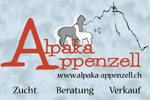Articles by Alpaca World Magazine:
Solva Alpacas
Alan Davies
Alan Davies describes how Solva Alpacas began and what happened next.
A maturing life insurance earmarked for purchasing a new car in the year 2000 didn?t, for it bought four female alpacas instead. Logical reasoning behind the excuse was that a new car wouldn?t buy an alpaca but an alpaca just might buy a new car. And so it was that the first two of the four arrived at Llys-y Coed in the Middle Mill Valley, Solva, Pembrokeshire, late on a wet Sunday afternoon in January 2001 when Tiffany and Butterfly stepped out of their trailer. This was after a four and a half hour journey from Bozedown Alpacas near Reading. During the couple of hours before darkness fell and despite the heavy drizzle, no fewer than 32 visitors clambered out of their vehicles to have a good look at animals they?d never set eyes on before. Six days later Ophelia and her cria Lily, purchased from Val Fullerlove of Hanley Swann, arrived, and that did it ? even the Harbourmaster, among others, demanded and got to know their names, such was the interest in these unusual animals. Gwen, my Auntie, on whose smallholding the alpacas were to be kept, declaring they were, ?? y pethau gorau?, (the best things) that had ever set foot there.
During the first six days, when there were just the two, Tiffany spent most of her time trying to dominate Butterfly by spitting and screeching while encircling her. In view of this it was wondered what would happen when the other two arrived. Surprisingly, as Ophelia emerged from the trailer she just put her ears back and Tiffany behaved from that very second. A chance remark, about a year later, led to the belief that Ophelia had had a name change since her importation from Chile and that her original name had been Yalena. Moreover, she was Tiffany?s mother and had sorted her antics with that simple ear-back stare. A stare seen countless times since because from that day to this Ophelia has established herself as the matriarch of the Solva herd, sorting everyone out. Now at the age of 23, and looking hardly any different from when she first arrived in Solva 14 years ago, she is thought to be the oldest alpaca in Wales and one of the oldest in Britain.
Cria get taught a lesson early in life. Should one have the temerity to come close enough to bother Ophelia, there?s no spitting - she simply lowers her neck behind that of the wayward youngster, in her eyes, and presses down while uttering a screech. There was the occasion when she was caught giving a relative newcomer named Irma a lesson. Irma, being taller, was standing motionless in the middle of a six acre field with her head held high and turned away from Ophelia who was standing at right angles and who was only managing to spit at the back of Irma?s head. It was plain to see from the expression on her face that Ophelia was not satisfied with the situation and thinking, ?I?m not getting you!? To achieve satisfaction she deliberately changed tactics by manoeuvring herself around so that her body became aligned alongside Irma?s which allowed her to stretch her neck across the front of Irma?s brisket to get her face over onto the other side where Irma?s was. Mission accomplished - this enabled her to spit successfully up into her hapless victim?s face. She then promptly walked off with the clear, smug expression, ?Now I?ve had you!? plainly to be seen.
Ophelia was retired from the breeding programme at the age of nineteen on giving birth to her last cria, subsequently named Prudence. In doing so she showed the other females how giving birth should be done. It took just 50 minutes from the waters breaking; to pushing Prudence?s head out; to Prudence, with just her head protruding into the world, commencing to communicate with her mother by humming and Ophelia turning her head and neck around to look at her daughter and to communicate back; to Prudence then being pushed out to fall onto the floor; to her then getting up, suckling, running around and using the toilet and Ophelia getting rid of the afterbirth. In comparison, another cria born at the same time, and to be known as Higgins later, took two hours to get up off the floor.
Incidentally, when sheep were kept they, more often than not, either lambed an hour before high tide or an hour before low tide whether in the daytime or middle of the night. It has since been thought, with the two cria being born within minutes of each other, that although female alpacas seem to be able to gear giving birth to day-time episodes, they too seem subject to the effect of the moon on tides and therefore the waters. But that remains unproven at the moment.
To begin with, non-pregnant females needed to travel long distances to the stud but acquiring some of our own later has obviated all the travelling. Management of males and females seems to work well with practically no fighting among the stud males, ever. They are kept in the meadows along the banks of the river Solva while the females and un-weaned cria live out of their sight in the fields above the valley and are only brought down the steep track to the valley floor when mating needs to be accomplished. Sheep were kept prior to the arrival of the alpacas and it proved impossible to keep these down in the valley in summer months with blow-fly strike being a serious menace and having to be on constant guard against maggots. In contrast, the alpaca males appear to be quite happy living in the meadows, even in the height of summer ? lack of lanolin in their fleeces not attracting the flies to lay their eggs. To date, just two weanlings in an up-stream meadow, who must have rolled in something before getting shorn, got struck on the same day ten years ago in 2005.
Naturally, keeping alpacas leads to heaps of fleece lying around once shearing has taken place. These heaps can become hillocks, even mountains unless something is undertaken to lessen the pile. In our case, apart from selling some of the finer raw fleece in small quantities to hand spinners a lot of the coarser fleece goes for needle felting. The remainder is sent away to be spun into yarn with a considerable amount spun into single ply suitable for hand knitting our unique product ? our Ria Voe Stoles.
Ria-Voe Stoles came about when a poultry showing friend, Kevin Williamson, hailing originally from Shetland, suggested I asked his Mum, Eileen, to knit some stoles. This led to a quantity of alpaca fleece being spun specifically into single ply (cobweb) which was what Eileen worked with when knitting traditional Shetland Lace patterns. The skills of knitting intricate open laced patterns in single ply naturally devour time and it can take up to sixty hours to knit just one stole. Each has then to be hand washed before being stretched on a specifically-made wooden frame to dry. Cosmopolitan and versatile in that they suit the younger wearer when worn casually while, on the other hand, are elegant and warm when worn with evening attire or to a wedding.
The trade name ?Ria-Voe Stoles? was decided upon because the alpacas themselves live near the ria or drowned river valley of Solva while Eileen, born in Shetland, lives in Brae on the banks of the Sullom Voe ? ?voe? being the Shetland term for ?ria?
.
Alpacas can bring such joy. This is not only due to their engaging, intelligent characters, wonderful eyes and being happy to greet you but the knock on friendships they can help forge. Without Solva Alpacas it is most unlikely that brilliant friendships with Paul & Lavinia Tester of Blossom Hill Alpacas and Alex and Ian Cooper of Glynllethr Alpacas would ever have happened. Then there?s Valerie, Lavinia?s Mum, who has taken to modelling, with style, our Ria-Voe Alpaca stoles on the cat-walk at Wonderwool Wales at Builth Wells annually each April. Mention just has to be made too, of my cousin Berryl and husband Colin who take delight in coming along to help man our ?Pembrokeshire Alpaca? Stall. Berryl, an avid knitter herself, helping to answer innumerable questions from the general public where knitting with alpaca wool is concerned! Daughter Lowri, never being adverse to modelling our stoles either.
My late friend, Eve Sendall, took no persuasion to travel hours on end when taking females off to the stud and, far from being perturbed or upset, laughed on realising she had been spat upon too by the only feisty alpaca in the herd. Anyone daring to do a Little Britain?s ?Look in my eyes!? to our Laurel invariably triggers an immediate, full force gobby reaction from her! She is only ?nice? when not pregnant, and so we have to make the most of the fortnight during the year when she is not and during which time she comes up to have her face tickled! The stud males know my truck not only by sound but by sight too; invariably running a third of a mile along the river?s bank to get to the home gate lest they miss something. They spend half their lives hovering near this gate and are literally nose to nose at times with the umpteen visitors that stop to say hello. My aunt was correct. Alpacas are the best things to have arrived in the valley.
Tweet



